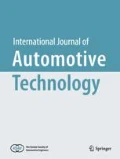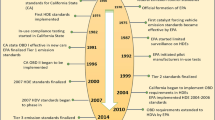Abstract
The main objectives of engine development, given the increased environmental regulations, are performance and efficiency improvement, and emission reduction. Notably, for diesel engines, the significance of fuel consumption and emission reduction is increasing because they emit harmful materials (PM, NOx); however, they are characterized by relatively low CO2 emission in comparison with gasoline engines. Various technologies have been developed to solve these problems of diesel engines; however, majority of the diesel engines are developed in a steady state, and yet their certification and evaluation include the transient state. The transient operation of diesel vehicles leads to additional fuel consumption and emission of NOx; however, the impact of transient operation has not been discussed thus far. Therefore, this study quantitively investigates the fuel consumption and NOx emission during the transient operation of a diesel vehicle. First, the engine and vehicle’s efficiency and NOx emission differences are derived and analyzed in the steady state. Subsequently, the effects of the vehicle’s transient operation are analyzed. A vehicle’s transient operation can be classified into two types: operational and thermal transient effects. Finally, the respective transient effects are quantified and analyzed.
Similar content being viewed by others
Abbreviations
- Wbrake :
-
engine brake work, J
- Wind :
-
engine indicated work, J
- Wpump :
-
engine pumping work, J
- Wegf :
-
engine friction work, J
- Walt :
-
alternator work, J
- Wwheel :
-
wheel input work, J
- Vauxbat :
-
auxiliary voltage, V
- Nwheel :
-
wheel speed, rpm
- Nveh :
-
vehicle speed, km/h
- Twheel :
-
wheel Torque, Nm
- Pcyl :
-
cylinder pressure, kPa
- Vcyl :
-
cylinder volume, m3
- ηalt :
-
efficiency of alternator
References
Brown, A., Nalbach, M., Kahnt, S. and Korner, A. (2016). CO2 emissions reduction via 48V active engine-off coasting. SAE Int. J. Alternative Powertrains 5, 1, 68–78.
Chung, I., Kang, H., Park, J. and Lee, J. (2019). Fuel economy improvement analysis of hybrid electric vehicle. Int. J. Automotive Technology 20, 3, 531–537.
Eastwood, P. G., Tufail, K., Winstanley, T., Darlington, A., Karagiorgis, S., Hardalupas, Y. and Taylor, A. M. K. P. (2010). Estimation of deviations in NO and soot emissions between steady-state and EUDC transient operation of a common-rail diesel engine. SAE Int. J. Engines 2, 2, 648–659.
Filipi, Z., Hagena, J. and Fathy, H. (2008). Investigating the impact of in-vehicle transients on diesel soot emissions. Thermal Science 12, 1, 53–72.
Hagena, J. R., Filipi, Z. and Assanis, D. N. (2006). Transient diesel emissions: Analysis of engine operation during a tip-in. SAE Technical Paper No. 2006-01-1151.
Herrmann, O. E., Biglia, M., Yasuda, T. and Visser, S. (2017). Diesel powertrain energy management via thermal management and electrification. SAE Technical Paper No. 2017-01-0156.
Hooflman, N., Messagie, M., Van Mierlo, J. and Coosemans, T. (2018). A review of the European passenger car regulations-real driving emissions vs local air quality. Renewable and Sustainable Energy Reviews, 86, 1–21.
Ntziachristos, L., Samaras, Z., Zervas, E. and Dorlhène, P. (2005). Effects of a catalysed and an additized particle filter on the emissions of a diesel passenger car operating on low sulphur fuels. Atmospheric Environment 39, 27, 4925–4936.
Peckham, R., Basu, S., Ribeiro, M. and Walker, S. (2017). Harmonizing and rationalizing lightweighting within fuel efficiency regulations across NA, EU and China SAE Int. J. Passenger Cars-Mechanical Systems, 10, 455–464.
Rakopoulos, C., Dimaratos, A., Giakoumis, E. and Peckham, M. (2010). Experimental assessment of turbocharged diesel engine transient emissions during acceleration, load change and starting. SAE Technical Paper No. 2010-01-1287.
Schröder, O., Krahl, J., Munack, A. and Bünger, J. (1999). Environmental and health effects caused by the use of biodiesel. SAE Trans., 1756–1766.
SPM, W. I. I. (2014). Working Group II Contribution to the IPCC Fifth Assessment Report (AR5). Climate Change 2014: Impacts, Adaptation and Vulnerability. Summary for Policymakers (www.ipcc.ch).
Thomas, J. (2016). Vehicle efficiency and tractive work: Rate of change for the past decade and accelerated progress required for US fuel economy and CO2 regulations. SAE Int. J. Fuels and Lubricants, 9, 290–305.
Torregrosa, A. J., Broatch, A., Olmeda, P. and Romero, C. (2008). Assessment of the influence of different cooling system configurations on engine warm-up, emissions and fuel consumption. Int. J. Automotive Technology 9, 4, 447–458.
Zervas, E., Poulopoulos, S. and Philippopoulos, C. (2006). CO2 emissions change from the introduction of diesel passenger cars: Case of Greece. Energy, 31, 2915–2925.
Author information
Authors and Affiliations
Corresponding author
Additional information
Publisher’s Note
Springer Nature remains neutral with regard to jurisdictional claims in published maps and institutional affiliations.
Rights and permissions
About this article
Cite this article
Chung, I.C., An, Y.K., Park, J. et al. Analysis of Engine Efficiency of Diesel Vehicle in Transient Operating Conditions. Int.J Automot. Technol. 22, 941–947 (2021). https://doi.org/10.1007/s12239-021-0085-4
Received:
Revised:
Accepted:
Published:
Issue Date:
DOI: https://doi.org/10.1007/s12239-021-0085-4




